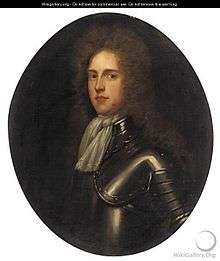William Tatton
William Tatton (1659–1736) was a career soldier in the British Army who rose to the rank of Lieutenant-General.
William Tatton | |
|---|---|
| Born | 1659 |
| Died | June 1736 Westminster, Middlesex |
| Allegiance | |
| Service/ | |
| Rank | Lieutenant-General |
| Commands held | |
| Battles/wars |
|

Career
As a trusted associate of John Churchill, 1st Duke of Marlborough throughout the War of the Spanish Succession, in April 1704 the Duke appointed him Colonel of the Horse Guards. In August 1704 he led the advance party for the Duke's bold dash to the River Danube, which led to the crushing defeat of the French and Bavarian forces at the Battle of Blenheim.[1] After this victory, Tatton was made Colonel of a Foot Regiment (which would later become the 24th Regiment of Foot and the South Wales Borderers), a post he held until 1708.[2]
After the war, the Army was involved in suppressing the Jacobite Rebellion of 1715, when Tatton was responsible for bringing convicted rebels to London to be imprisoned.[3]
He finally reached the rank of Lieutenant-General.[4] From 24 November 1729 until his death, he was Colonel of The Buffs, the 3rd Regiment of Foot, then still known as the Holland Regiment serving the Prince of Orange.[5]
He died in June 1736 and was buried at Hillingdon in Middlesex.[6] His will was proved in London on 19 June 1736.[7]
Family
His first marriage was to Elizabeth Bull, sister of Sir John Bull. Their daughter Katharine in 1724 married Edward Nevill, 15th Baron Bergavenny and in 1725, after his death, his cousin William Nevill, 16th Baron Bergavenny.
He married secondly Ann Harvey, daughter of Dr Gideon Harvey, on 26 February 1717 at the church of St Mary Aldermary, London. Their daughter Elizabeth in 1741 married Henry Flower, 1st Viscount Ashbrook.[8]
His arms were « quarterly first and fourth ar a crescent sa second and third gu a crescent ar Crest a greyhound sejant tied at the neck to a hawthorn tree ppr by a band or ».[9]
References
- Lindsay, Colin. 1793. « Extracts from Colonel Tempelhoffe's History of the seven years war: his remarks on General Lloyd: on the subsistence of armies; and on the march of convoys. Also a treatise on winter posts [by K. F. Lindenau] To which is added a narrative of events at St. Lucie and Gibraltar, and of John duke of Marlborough's march to the Danube, with the causes and consequences of the measure » London, T. Cadell, 1793 https://books.google.co.uk/books Retrieved 9 October 2015
- Wilkinson-Latham, Christopher. 1975 «The South Wales Borderers » Osprey Publishing https://books.google.co.uk/books Retrieved 9 October 2015
- Charles, George 1816 « History of the Transactions in Scotland » https://books.google.co.uk/books Retrieved 7 October 2015
- http://www.thepeerage.com/p1712.htm citing G.E. Cokayne; with Vicary Gibbs, H.A. Doubleday, Geoffrey H. White, Duncan Warrand and Lord Howard de Walden, editors, »The Complete Peerage of England, Scotland, Ireland, Great Britain and the United Kingdom, Extant, Extinct or Dormant », new ed., 13 volumes in 14 (1910-1959; reprint in 6 volumes, Gloucester, U.K.: Alan Sutton Publishing, 2000), volume I, page 269. Retrieved 8 October 2015
- http://www.britishempire.co.uk/forces/armyunits/britishinfantry/buffscolonels.htm Retrieved 8 October 2015
- http://www.thepeerage.com/p1712.htm citing G.E. Cokayne; with Vicary Gibbs, H.A. Doubleday, Geoffrey H. White, Duncan Warrand and Lord Howard de Walden, editors, »The Complete Peerage of England, Scotland, Ireland, Great Britain and the United Kingdom, Extant, Extinct or Dormant », new ed., 13 volumes in 14 (1910-1959; reprint in 6 volumes, Gloucester, U.K.: Alan Sutton Publishing, 2000), volume I, page 269. Retrieved 8 October 2015
- PROB 11/677/386 Will of William Tatton, Lieutenant General of His Majesty's Forces, of Saint Margaret Westminster, Middlesex http://discovery.nationalarchives.gov.uk/details/r/D658045 Retrieved 8 October 2015
- http://www.thepeerage.com/p1712.htm citing G.E. Cokayne; with Vicary Gibbs, H.A. Doubleday, Geoffrey H. White, Duncan Warrand and Lord Howard de Walden, editors, « The Complete Peerage of England, Scotland, Ireland, Great Britain and the United Kingdom, Extant, Extinct or Dormant », new ed., 13 volumes in 14 (1910-1959; reprint in 6 volumes, Gloucester, U.K.: Alan Sutton Publishing, 2000), volume I, page 269. Retrieved 8 October 2015
- Berry, William. 1828 « Encyclopaedia Heraldica Or Complete Dictionary of Heraldry » https://books.google.co.uk/books Retrieved 8 October 2015
| Military offices | ||
|---|---|---|
| Preceded by Thomas Pitt, 1st Earl of Londonderry |
Colonel of Regiment of Foot 1729–1737 |
Succeeded by Thomas Howard |